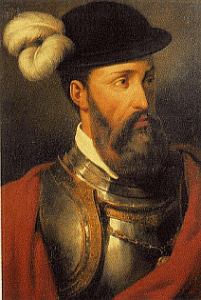On 26th June 1541, Francisco Pizarro – Spanish conquistador and murderous subjugator of the Inca Empire – got his just desserts when he was assassinated by his own people. The old ruffian, near 70, was seated at dinner with several close friends and relatives, when twenty armed men – led by the son of his former close companion, Diego de Almagro, who Pizarro had cold-heartedly condemned to death – burst into his palace in Lima. The startled tyrant leapt up, tore a sword from the wall, and killed three of his assailants before being stabbed in the throat. Crying “Jesus!”, Pizarro fell to the cold palace floor. Ever the faithful servant to the Christian god in whose name he’d killed millions, he managed to paint the sign of the cross with his own blood and piously kissed it before expiring.
It was a suitably violent and dramatic end for this ruthless, illiterate adventurer whose very name – like his distant cousin Cortés – is synonymous with greed, treachery and annihilation.
We must however concede that the bastard was an astonishing military genius. With only 106 foot soldiers and 68 horsemen, Pizarro ambushed the great plaza of Cajamarca high in the Peruvian Andes, killed over 5,000 Incas and captured the mighty emperor Atahualpa. Based on sheer numbers alone, Pizarro’s victory stands as one of the most improbable in recorded military history.
For nine months after the infamous Battle of Cajamarca, Pizarro held Atahualpa prisoner – forcing the emperor to act as a frontman while the Spaniard took over his empire. Appealing to his captor’s insatiable greed, Atahualpa attempted to buy Pizarro off – promising a room full of gold and two of silver in exchange for his liberation. Pizarro happily agreed to the deal, then promptly brought Atahualpa up on charges of adultery, idolatry and insurrection. Pizarro, an illegitimate commoner, then sentenced to death the noble leader of 10 million. Furthermore, Atahualpa was to be burned at the stake – a fitting death for a heathen, so thought the pious Spanish, but purgatory according to Incan beliefs. At the last moment, Atahualpa was offered clemency if he would convert to Christianity. The emperor submitted, and was executed by strangulation. Pizarro ordered that the corpse be burned anyway.
The execution of Atahualpa set in motion the conquest of the whole of the Inca Empire. While every indigenous population that encountered Europeans from the fifteenth century onwards met with catastrophe, the Incas suffered a particularly rapid decline. The new Spanish rulers brutally oppressed and suppressed their traditions. All aspects of Inca culture were systematically destroyed. The Spaniards introduced a forced-labour system in the gold and silver mines – creating unparalleled wealth for Spain, while most of the Indian workers died within two years. The carefully balanced system of irrigation and food storage was destroyed, causing widespread famine. The effects of European diseases, especially smallpox, were even more devastating. In just one century, the population of the former empire fell from an estimated 10 million to 670,000.
Pizarro, meanwhile, busied himself by consolidating Spain’s control over Peru, overseeing the construction of Lima, ensuring he and his three brothers reaped the benefits of their efforts, and fathering children by Inca girls as young as 15. His struggle for power with his former companion, Almagro, was but a mild diversion from the enjoyment of his vast wealth, attained through the blood of millions of Incas.
On the anniversary of his death, who would shed a tear for this World Annihilator?



40 Responses to 26th June 1541 – the Death of Francisco Pizarro